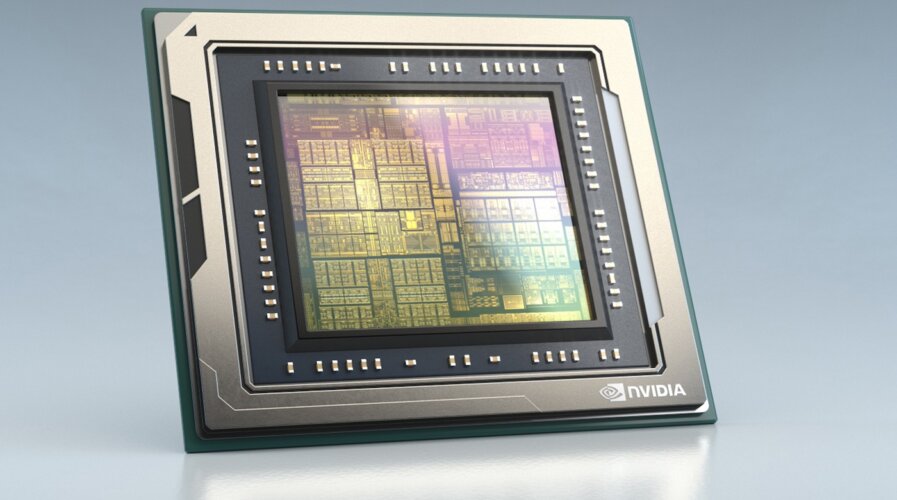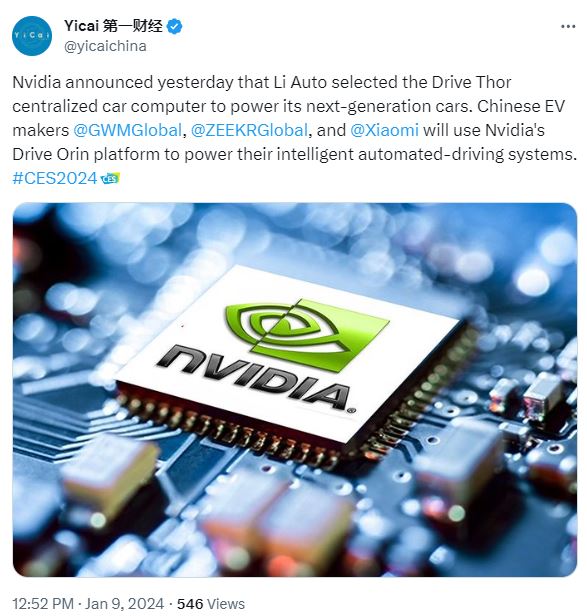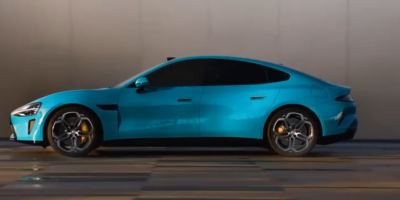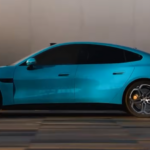
Chinese EV manufacturers have also adapted Nvidia Drive solutions to boost their vehicle’s performance. (Image – NVIDIA)
Chinese EVs pick Nvidia Drive for automated driving
- Chinese EVs are taking the industry by storm.
- Nvidia is providing them with the technology needed to improve their performance and capabilities.
- At CES 2024, Nvidia announced new partnerships with Chinese EV manufacturers.
Nvidia continues to innovate and play an important role in the development of many industries around the world. From AI to gaming laptops, Nvidia’s success depends on the companies it has partnered with over the years.
True, Nvidia’s chips and technology are vital to most of the world’s biggest manufacturing companies. And its success has not gone unnoticed. Rivals are hoping to catch up with Nvidia, pouncing on any available opportunities in any industry.
For Nvidia, the competition is a spur to improve its products and capabilities, and stay ahead of the pack. For example, when the US announced chip restrictions on China, Nvidia was quick to develop a substitute chip for the Chinese market. Even when the new chips fell under regulations, Nvidia was still able to come up with newer chips to meet the demand.
Jensen Huang, Nvidia CEO, remains committed to meeting customer needs and providing them with the best products in the market. And it seems that regulations may slow down the company in one area, but also open the doors to other possibilities.

Chinese EVs choose Nvidia for autonomous driving tech.
Nvidia Drive at CES
Nvidia’s capabilities in the electric vehicle (EV) industry are growing. At CES 2024, Nvidia announced new partnerships with Chinese EV manufacturers. Specifically, Li Auto, Great Wall Motor (GWM), Zeekr and Xiaomi will be using Nvidia Drive solutions to power their vehicles.
Li Auto, which is known for its extended-range EVs has selected the Nvidia Drive Thor centralized car computer to power its next-generation fleets. Drive Thor is a next-generation centralized car computer that integrates a wide range of intelligent functions into a single AI compute platform, delivering autonomous driving and parking capabilities, driver and passenger monitoring, and AI cockpit functionality.
Currently, Li Auto is using two Nvidia Drive Orin processors to power its assisted-driving system, AD Max, for its L-series models. Providing a combined 508 trillion operations per second (TOPS), the processors enable real-time fusing and processing of sensor information. This powers full-scenario autonomous driving for navigation on advanced driver-assistance systems (ADAS), full-scenario assisted driving for lane change control (LCC), automated parking and automatic emergency braking (AEB) active safety features.
Li Auto’s AD Max 3.0 upgrade, which was unveiled in December 2023, transitions the system to an end-to-end algorithmic architecture dominated by large AI models. It delivers a safer, more comfortable intelligent driving experience using an occupancy network and spatio-temporal trajectory planning and model-predictive control algorithms.
Chinese EVs confident of Nvidia Drive capabilities
The other three Chinese EV manufacturers have also adapted Nvidia Drive solutions to boost their vehicle’s performance. GMV’s self-developed, high-end intelligent drive system Coffee Pilot will be based on the Drive Orin centralized computing platform. Coffee Pilot can support parking, high-speed and urban scenes to achieve full-scenario smart navigation and assisted-driving functions without high-precision maps.
Collaborating with Nvidia, the first model of this intelligent driving system is expected to debut in the first half of the year. Advanced intelligent-driving features, such as Urban Navigate on Autopilot and cross-floor Memory Parking, will be first rolled out in GWM’s WEY models.
On the other hand, premium EV carmaker Zeekr has launched the Zeekr luxury sedan, its fourth model to be powered by Nvidia Drive Orin. A subsidiary of Geely, the Luxury Sedan features a new full-stack smart driving system, powered by two Drive Orin systems-on-a-chip, to deliver intelligent parking and automated operation on high-speed and urban roads.
Zeekr’s full range of models is offered with two sensor options – Lidar + Vision Fusion and Pure Vision. The Navigation Zeekr Pilot, a highway navigation feature from Zeekr’s in-house advanced driving assistant system, will be available for use in major Chinese cities once deliveries begin.
Chen Qi, vice president of Zeekr, mentioned that the new Zeekr luxury sedan’s in-house-developed ADAS system is made possible with the energy-efficient, high-performance Nvidia Drive car computing platform.
Meanwhile, Xiaomi’s EV, the SU7 sedan, is built on a dual Drive Orin configuration for highway driving functions. Built using Xiaomi’s leading large language model for perception and decision-making, the sedan will be able to seamlessly navigate through Chinese cities, regardless of locale, administrative divisions within the country, or type of road.
The SU7 will come in two versions. The first one has a driving range of up to 415 miles on a single charge and the other with a range of up to 497 miles. The SU7 will be officially launched in the first half of 2024.

Mercedes Benz is using digital twins for production with help from Nvidia Omniverse. (Image – Nvidia).
The future of autonomous vehicles
Interestingly, Chinese EVs are not only the only vehicles relying on Nvidia. Several European and American vehicle manufacturers have also announced plans to use Nvidia’s technology in their models. This includes:
- Mercedes-Benz – apart from announcing a voice assistant in new models, the Concept CLA Class is using Nvidia Drive Orin for the automated driving domain. Mercedes-Benz is also using digital twins for production with help from Nvidia Omniverse, a platform for developing applications to design, collaborate, plan and operate manufacturing and assembly facilities.
- Kodiak– known for the autonomous truck, it relies on Nvidia GPUs for high-performance compute to process the enormous quantities of data it collects from its cameras, radar and lidar sensors.
- Pebble – the recreational vehicle startup is presenting its flagship product Pebble Flow, the electric semi-autonomous travel trailer powered by Nvidia Drive Orin, with production starting before the end of 2024.
- Polestar– the Polestar 3 is powered by the Nvidia Drive Orin central core computer.
- Zoox– leverages Nvidia technology for the latest generation of its purpose-built robotaxi.
Several other tech companies are also showcasing their capabilities with Nvidia Drive at CES. Interestingly, the use of the technology by Chinese EV makers seems to not have any concern for now. However, it could be only a matter of time before the technology could end up having the same fate as some of Nvidia’s chips in China.
For now, it seems that Nvidia remains focused on improving the capabilities of its solutions and providing its customers with the best tools in the industry.
READ MORE
- Strategies for Democratizing GenAI
- The criticality of endpoint management in cybersecurity and operations
- Ethical AI: The renewed importance of safeguarding data and customer privacy in Generative AI applications
- How Japan balances AI-driven opportunities with cybersecurity needs
- Deploying SASE: Benchmarking your approach




